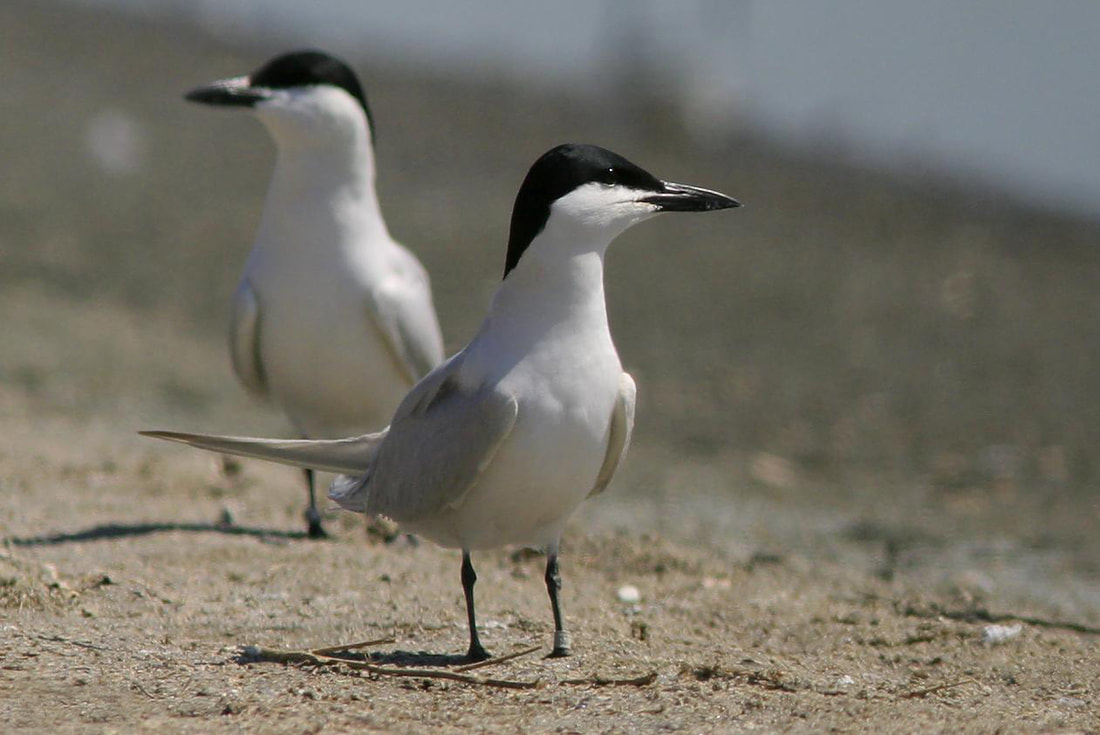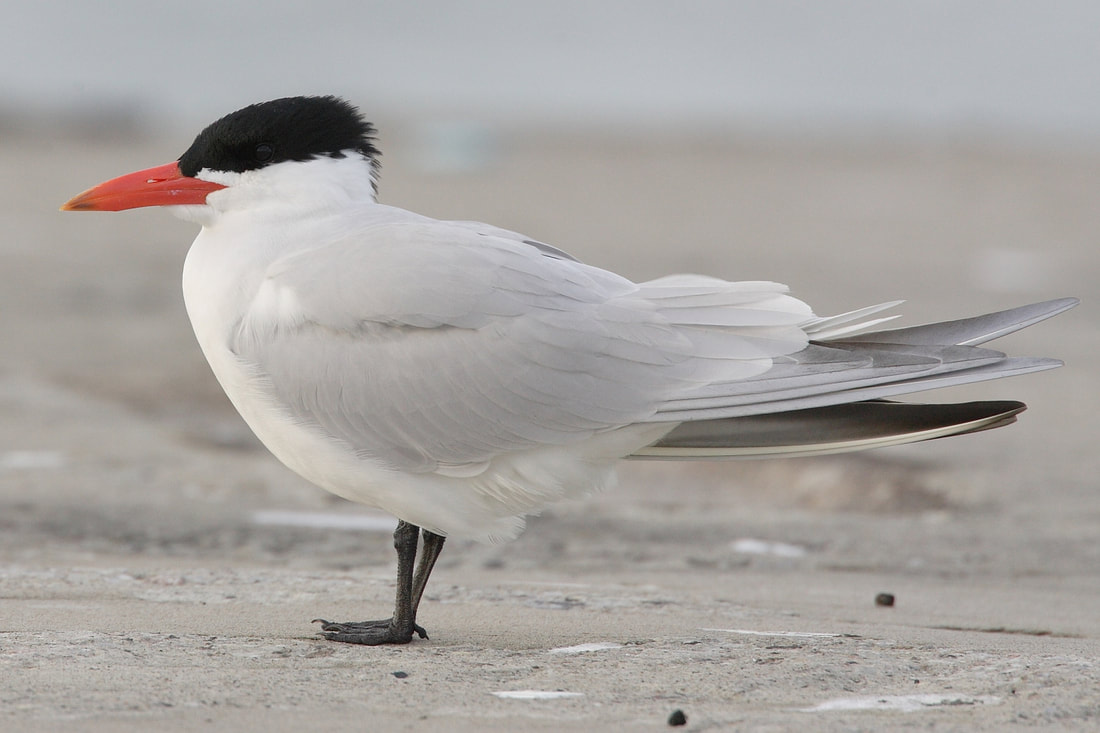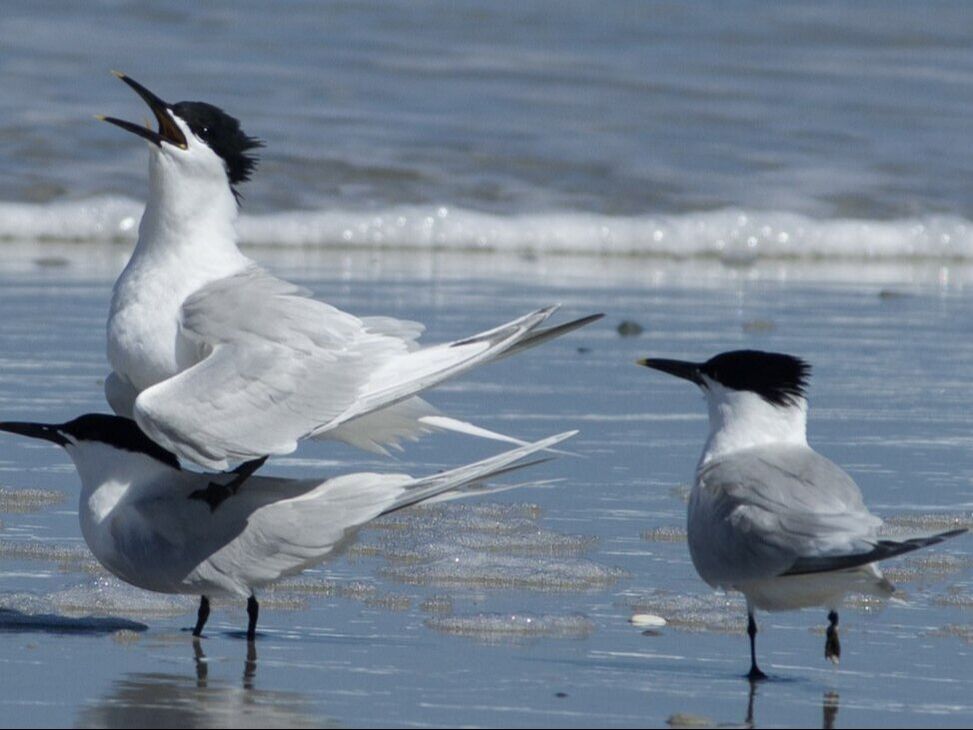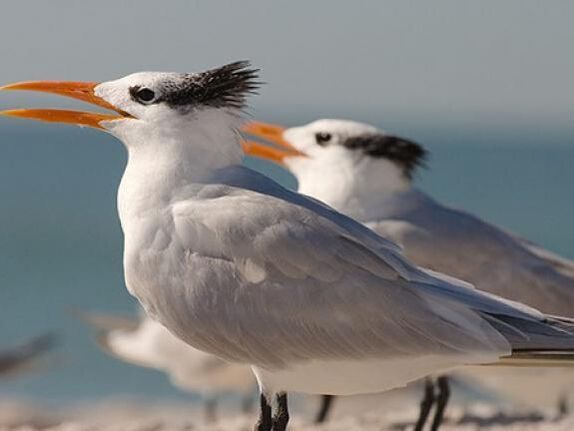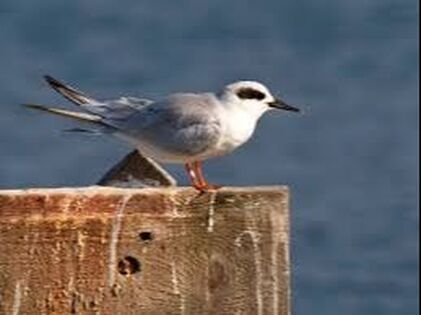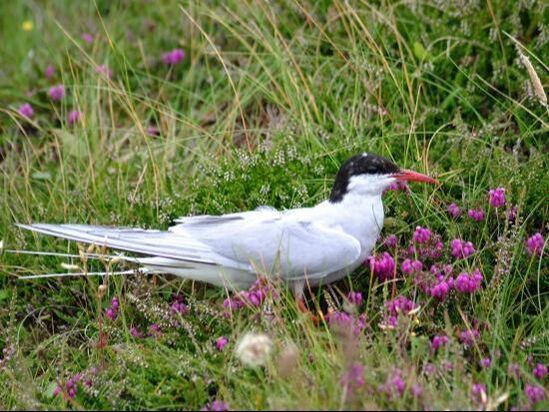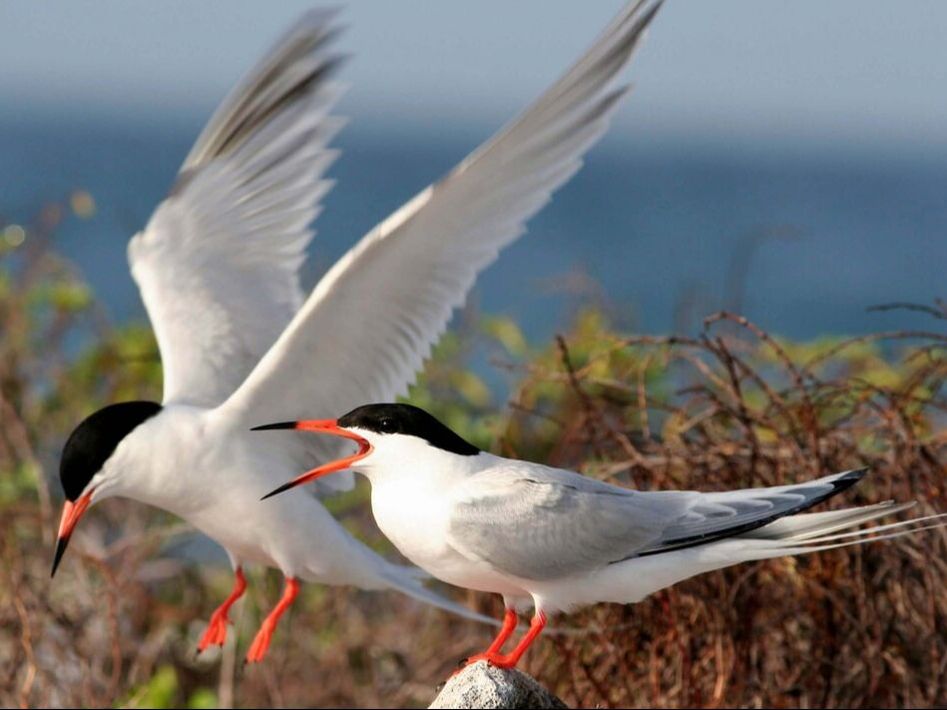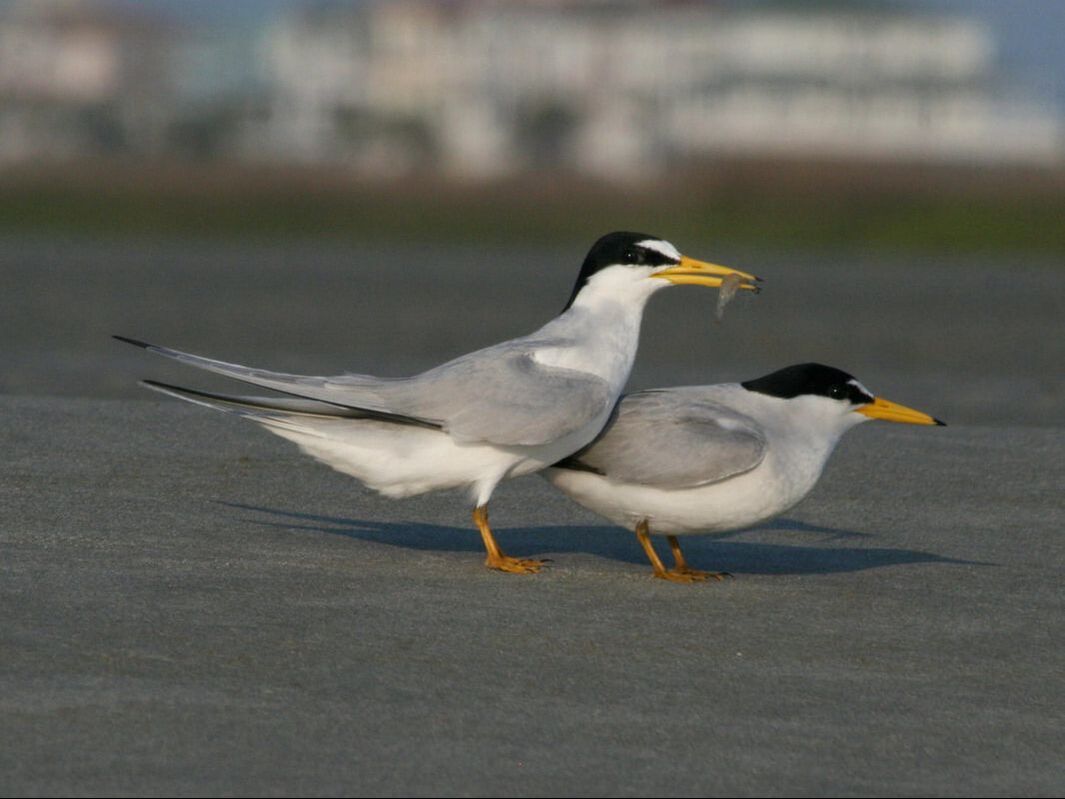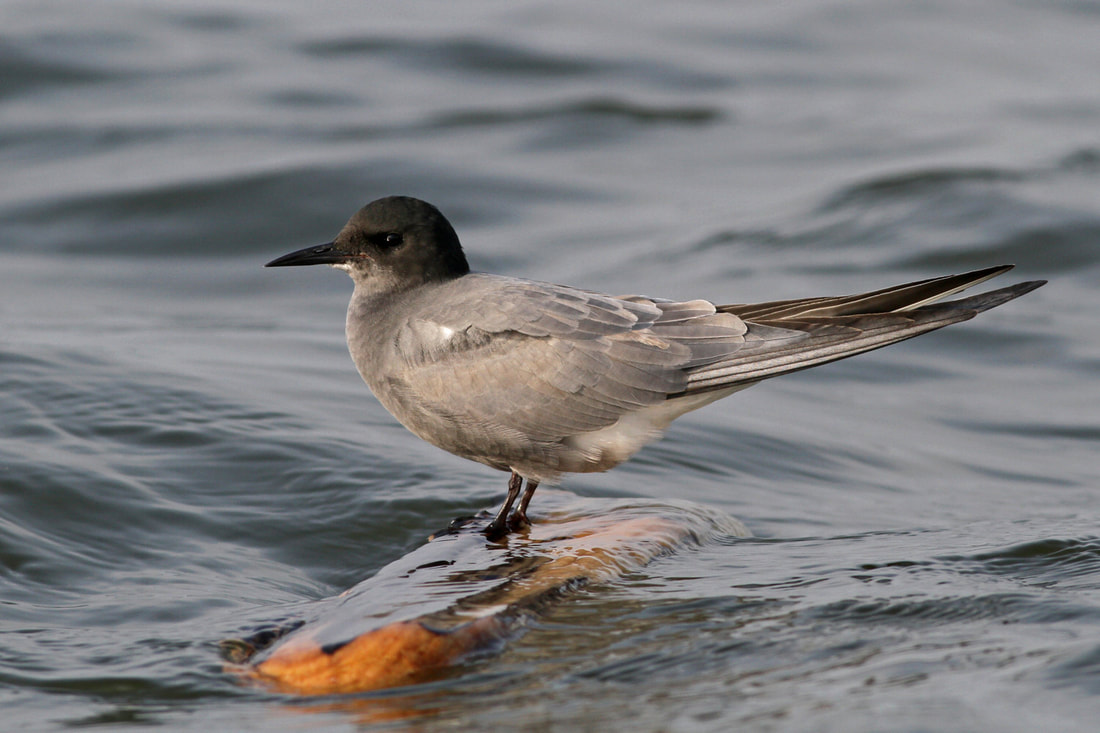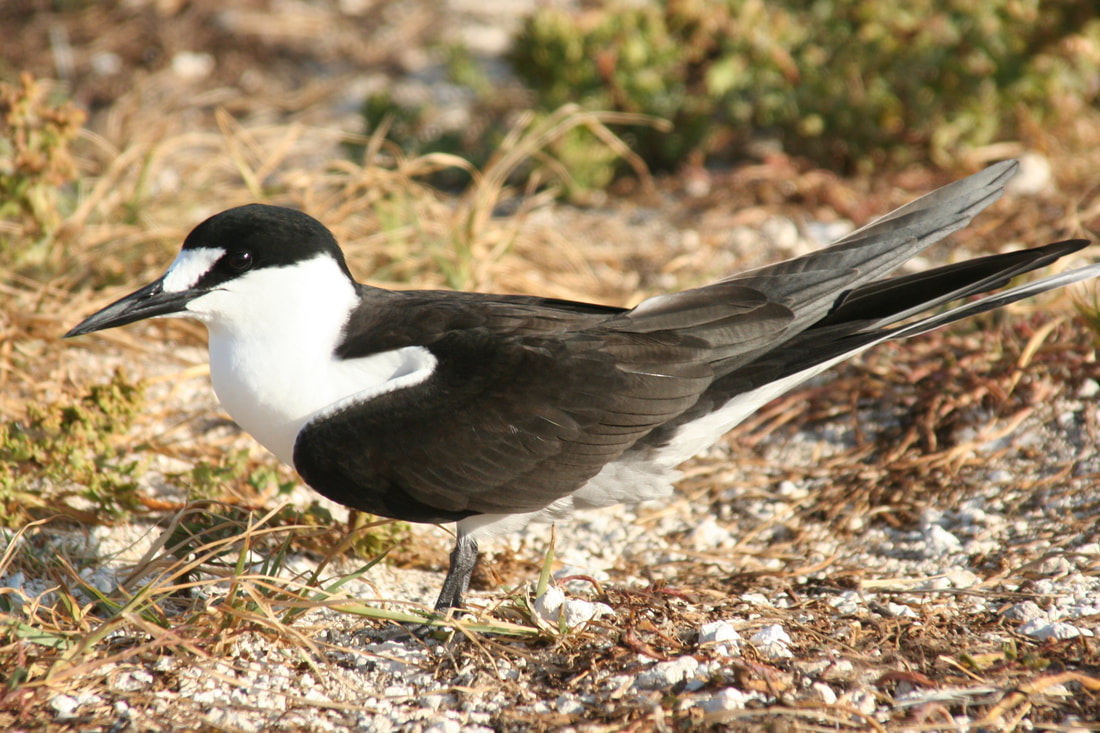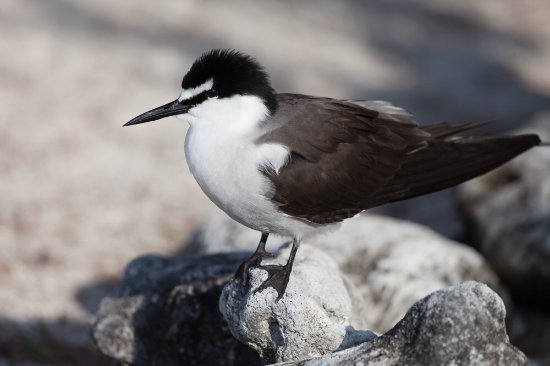Terns - in Belize
Gull-Billed Tern
Gull Billed Tern - Medium-sized tern with thick black bill. Very pale overall with black cap in breeding plumage. Legs black. Nonbreeding plumage shows dark cheek patch. Found in marshier habitats than most other terns, usually near the coast but not on the ocean, though also occasionally seen on beaches and mudflats. Rarely seen in flocks with other terns; often single or in pairs. Feeds on invertebrates and crabs in mud and marshes; often patrols the edges of ponds but does not grab fish from the water like other terns.
BELIZE HABITAT - Shrimp farms, lagoons, beaches. Where can I find this bird in Belize? Uncommon winter visitor and locally fairly common migrant along and near mainland coast, mid-July to mid-May. Most common in spring at Crooked Tree Belize; occasional transient on cayes. |
Caspian Tern
Caspian Tern - Largest tern in the world. Thick, bright-red bill is distinctive. Note solid black cap in summer, which turns to black streaks in winter. Feeds by cruising over lakes, rivers, estuaries, and reservoirs looking for fish, then plunging to catch them. Smooth wingbeats, more gull-like than choppy flight of small-bodied terns. Very vocal, giving loud raucous screams.
BELIZE HABITAT - Shrimp farms, lagoons, estuaries. Where can I find this bird in Belize? Uncommon and local winter visitor along and near coast south to Dangriga, rarely to Toledo, primarily mid-August to early May, occasionally to mid-June, and perhaps through summer. Occasionally on north cayes. Most common at Crooked Tree Belize in spring. |
Sandwich Tern
Sandwich Tern - Pale medium-sized tern with distinctive yellow tip on black bill. Shows a shaggy black cap in breeding plumage; nonbreeding birds develop white forehead. Strictly coastal; most commonly found on beaches and estuaries, often mixed with flocks of other terns. Harsh grating calls similar to other terns.
BELIZE HABITAT - Beaches, cayes, shrimp farms. Where can I find this bird in Belize? Common winter and failry common summer resident on cayes and along mainland coast; less common at cayes; once inland at Lamanai Orange Walk. Small breeding colonies persist on several small cayes. Non-breeding population in elize has increased greatly since early 1960's. Four banded birds wintering in Punta Gorda were banded as nestlings on southeast coast of North Carolina. |
Royal Tern
Royal Tern - Large tern, found strictly in coastal areas. Feeds in open ocean and saltwater bays, where it flies high above the water looking for small fish. Rests on beaches, often in groups with other species. Separated from many terns by large size; only slightly smaller than Caspian. Look for the thinner orange bill (usually not deep red) and shaggier crest compared with Caspian. Also, forehead whiter than Caspian Tern in the nonbreeding season; this can show as early as midsummer.
BELIZE HABITAT - Beaches, cayes, shrimp farms. Where can I find this bird in Belize? Year round visitor on immediate coast and cayes. Common in winter; local and generally uncommon in summer. Recorded once inland near La Democracia Belize/Cayo. Seventeen banded birds recovered in Belize were all banded as nestlings on the U.S. Atlantic coast between Maryland and North Carolina. |
Forester's Tern
Forester's Tern - Smaller than all the gulls, with thinner and more pointed bill. Distinguished from other terns by pale whitish wings and orange-based bill in summer, and isolated black ear patch in winter. Forages by circling and hovering over bays, ponds, and lakes, then dropping to snatch fish. Often rests on sandbars, piers, and other structures with other gull and tern species. Snappy, quick wingbeats and acrobatic in flight.
BELIZE HABITAT - Lagoons, marshes, beaches. Where can I find this bird in Belize? Occasionally transient and winter visitor, late August to mid-April, mostly in north. |
Common Tern
Common Tern - Medium-sized tern found on open ocean, beaches, and large lakes. Adults have pale gray body and black cap. Bill color differs by subspecies: most have red bill with black tip, but some Asian birds have all-black bills. First-years show dark outer primaries, dark shoulder, and black restricted to back of neck. Similar to Forster's, Arctic, and Roseate Terns. Separated from breeding Forster's Tern by entirely gray upperwings; nonbreeding Forster's shows black ear patch. Somewhat longer-billed and shorter-tailed than Arctic Tern, with paler body. Shorter-tailed and overall darker than gleaming white Roseate Tern. Often found in large flocks, especially in late summer. Gives a harsh screeching call "KEEE-yurrrr."
BELIZE HABITAT - Offshore waters, coastal beaches, estuaries. Where can I find this bird in Belize? Seasonal distribution complex and not fully understood. Generally uncommon to very uncommon transient and winter visitor offshore, at cayes, and along mainland coast; early September (and probably August) to late May. Occasionally fairly common to common in migration, at least in spring. Unrecorded inland. |
Roseate Tern
Roseate Tern - Graceful pale tern with extremely long forked tail. Named for faint rosy wash on belly. Bill color varies geographically; Old World birds arrive on breeding grounds with a black bill that turns to red, while New World birds arrive with a red bill that turns darker. Similar to Common Tern, but notably whiter wings. With practice, look for shallow, choppier wingbeats to distinguish from other tern species. Widespread across the globe but local, breeding in scattered colonies, often on offshore islands. Can be found mixed in flocks with other terns on beaches, mudflats, or estuaries. Listen for harsh two-parted call "chivick."
BELIZE HABITAT - Small cayes, ocea; occasionally coastal beaches. Where can I find this bird in Belize? Uncommon to locally fairly common summer visitor offshore, April to late September, occasionally to November; regular along mainland coast. Formerly more common, but most nesting colonies have been replaced by resorts and fishing camps. Nesting colony persists on Tobacco Caye off Dangriga; possibly other small colonies elsewhere. |
Least Tern
Least Tern - Tiny, noticeably smaller than other terns, with quick flicking wingbeats. A real beach bum, rarely straying far from sand, both on the coast and along inland rivers and lakes. Breeding adults have yellow bill, stumpy yellow feet, white forehead, and black cap. Younger birds duller with black bill, blackish crown patch, and grayish shoulder, but still always identifiable by size and quick wingbeats. Often seen with other terns. Listen for shrill high-pitched calls.
BELIZE HABITAT - Coastal beaches, shrimp farms. Nests on isolated sandy beaches and dunes with patchy herbaceous vegetation. Where can I find this bird in Belize? Locally fairly common summer resident on a few cayes and along mainland coast south to north Toledo, mid-March to early October; occasionally in winter. |
Black Tern
Black Tern - Small tern with an entirely black body in breeding plumage with silvery wings. In the winter, their body is whitish-gray and they are not as conspicuous, but note small size, rather dark gray wings and rump, and black "helmet." Breeds in colonies in freshwater marshes and ponds. Builds a floating nest of plant matter. In migration and winter, often found in flocks. Feeds on insects and small fish.
BELIZE HABITAT - Offshore waters, large inland lagoons. Where can I find this bird in Belize? Fairly common to common autumn and occasionally spring transient, early August to early November, and late April to late May. Most plentiful offshore in autumn, but also fairly common at times at shrimp farms and inland lagoons. |
Sooty Tern
Sooty Tern - This tropical seabird is distinctive among terns with its jet-black back, black cap, and neat white forehead. Immature birds are entirely dark blackish with white spots on wings and a white undertail. Most similar to Bridled Tern, but darker black back, dark undersides of flight feathers, and narrower white edges on tail. Sooty Tern nests on sandy islands and is found in warm tropical waters. However, it usually stays far offshore, and is rarely seen near land except when blown off course by a hurricane.
BELIZE HABITAT - Offshore and isolated small cayes, where it nests in coral rubble beneath trees and shrubs. Where can you find this bird in Belize? Locally fairly common summer resident offshore, February to mid-August (occasionally later). Moderate to large colonies bred historically on a few south cayes; now greatly reduced as cayes where it formerly bred have been developed for tourism or occupied as fishing camps. Only known remaining nesting colony is on Middle Snake Caye, and it is threatened by repeated human disturbance. Rarely recorded far inland after major storms. An emaciated bird recovered in inland Stann Creek on the unreasonable date of November 26, 1997 had been banded in Florida on June 6, 1966 (3-1/2 years earlier) |
Bridled Tern
Bridled Tern - Tropical tern with gray back, black cap, and white forehead. Very rarely seen near land except when blown off course by a hurricane. Frequently perches on floating wood or other debris far offshore. Most similar to Sooty Tern but paler gray above with more extensive white tail edges and paler undersides of flight feathers. Young birds show whitish head with pale barring on wings and back.
BELIZE HABITAT - Offshore and isolated small cayes, where it nests in coral rubble, often with sparse vegetation. Where can I find this bird in Belize? Locally fairly common summer resident offshore. Small nesting colonies persist on several small cayes off central and south Belize. Rarely seen from mainland. Dates of spring arrival unclear, but nests with eggs present in early April. Not rerecorded after mid-September. |

